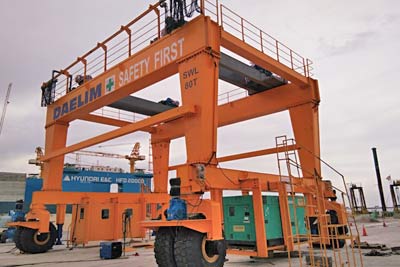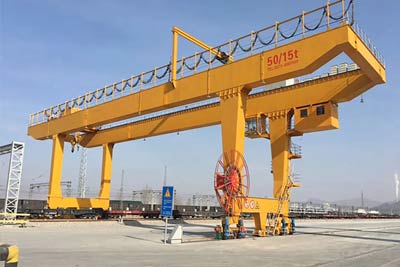Terminal Yard Cranes for Efficient Port Yard Container Handling
Terminal yard crane for sale to improve your container handling efficiency & safety in port yard. Check Container handling terminal yard crane overview now.
A terminal yard crane, also known as a container yard crane or a container handler, is a type of heavy-duty mobile crane used in port terminals, intermodal yards, and container depots. It is specifically designed for stacking, lifting, and moving shipping containers within the terminal yard. Terminal yard cranes are typically equipped with specialized spreader attachments that can securely grip and lift containers of various sizes and weights. These cranes are essential in facilitating the efficient movement and organization of containers in a terminal, ensuring smooth operations and maximizing storage capacity.
A terminal yard crane is a type of crane used in container terminals to move containers from one place to another. It is designed to handle heavy loads and has a high lifting capacity.
Functions and purpose of termial yard crane
The primary function of a terminal yard crane is to move containers from one location to another within a container terminal. This includes loading and unloading containers from ships, stacking containers in the yard, and transferring containers to and from other modes of transportation, such as trucks or trains.
The purpose of a terminal yard crane is to improve the efficiency and speed of container handling operations. By using a crane with a high lifting capacity and advanced features, containers can be moved quickly and safely, reducing the time it takes to load and unload ships and transfer containers between modes of transportation. This helps to reduce overall shipping costs and increase productivity in the container terminal. Additionally, terminal yard cranes are designed with safety features to prevent accidents and ensure the safety of workers and equipment.
What kinds of containers can be handled ?
Terminal yard cranes are designed to handle a variety of container types, including standard 20-foot and 40-foot containers, as well as larger 45-foot and 53-foot containers. They can also handle refrigerated containers, known as reefers, which require specialized equipment to maintain a constant temperature. Additionally, terminal yard cranes can handle open-top containers, flat racks, and other specialized container types. The specific types of containers that can be handled by a terminal yard crane depend on the model and lifting capacity of the crane, as well as the configuration of the container terminal.
Types: Rubber-tired gantry crane (RTG) Rail-mounted gantry crane (RMG) Ship-to-shore crane (STS) Straddle carrier.

Rubber-tired gantry crane (RTG):
Features:
- Runs on rubber tires, making it mobile and flexible
- Can lift containers stacked up to 6 high
- Equipped with advanced safety features, such as anti-collision systems and load-sway reduction technology
Advantages:
- High mobility allows for easy relocation within the terminal
- Can handle a variety of container types and sizes
- Faster and more efficient than manual container handling
Disadvantages:
- Limited lifting capacity compared to other types of cranes
- Rubber tires can wear out quickly, requiring frequent replacement

Rail-mounted gantry crane (RMG):
Features:
- Runs on rails, providing stability and precision
- Can lift containers stacked up to 8 high
- Equipped with advanced safety features, such as anti-collision systems and load-sway reduction technology
Advantages:
- High lifting capacity and precision
- Efficient and stable operation, even in windy conditions
- Can cover a large area of the container terminal
Disadvantages:
- Limited mobility compared to other types of cranes
- Requires a dedicated rail system, which can be expensive to install and maintain
Features of terminal yard cranes
Terminal yard cranes play a vital role in the efficient and safe handling of containers in ports, terminals, and intermodal yards. With their robust capabilities and advanced features, these cranes offer numerous benefits to optimize operations, improve productivity, and enhance safety. Let's explore the key features and advantages of terminal yard cranes that make them a valuable investment for buyers.
- Efficiency and Productivity - Terminal yard cranes are designed to maximize efficiency and productivity in container handling operations. Equipped with advanced automation technologies, these cranes can be remotely operated or even operate autonomously, reducing the need for manual labor and increasing operational efficiency. The use of automation also minimizes the time required for container transfers and improves overall yard throughput.
- Energy Efficiency -With growing environmental concerns, energy efficiency has become a critical factor for buyers. Terminal yard cranes offer various energy-saving features to reduce fuel consumption and minimize carbon emissions. Regenerative braking systems capture and convert kinetic energy into electrical energy, optimizing energy usage. Additionally, hybrid power options, such as a combination of electric and diesel, provide further fuel efficiency benefits.
- Safety and Operator Well-being - Safety is paramount in terminal operations, and yard cranes offer advanced safety features to protect workers and equipment. Proactive collision detection systems and cameras enhance crane operations by preventing accidents and reducing damage risks. Comprehensive operator training programs ensure operators possess the necessary skills to handle the equipment safely. These safety measures contribute to a secure working environment while protecting the valuable cargo being handled.
- Data Analytics and Inventory Management - Terminal yard cranes integrate cutting-edge technologies that enable comprehensive data analytics and real-time inventory management. By leveraging data collected from the cranes and other systems, operators can gain actionable insights into operational performance, identify areas for efficiency improvement, and make informed decisions to optimize workflow. Real-time inventory management systems facilitate easy tracking and movement of containers, minimizing delays and maximizing efficiency.
- Maintenance and Downtime Reduction- Downtime can significantly impact operations, leading to delays and increased costs. Terminal yard cranes leverage remote monitoring systems and predictive maintenance technologies to minimize downtime. Real-time monitoring allows operators to detect potential issues before they escalate, enabling timely maintenance and reducing unexpected breakdowns. Predictive analytics algorithms leverage historical data to predict maintenance needs, resulting in proactive maintenance practices and reduced downtime.
- Integration and Interoperability-Terminal yard cranes can seamlessly integrate with various terminal operating systems (TOS), as well as other technologies like RFID, GPS, and IoT devices. This integration enables smooth data flow, efficient container movement, and accurate tracking. By integrating with TOS, operators can optimize crane utilization, share real-time data, and facilitate streamlined operations.
- Environmental Considerations- In an era of sustainability, customers are increasingly seeking equipment that minimizes environmental impact. Terminal yard cranes offer eco-friendly alternatives such as electric or hydrogen-powered options, significantly reducing greenhouse gas emissions and noise pollution. These environmental considerations align with green initiatives and demonstrate a commitment to sustainability.
Terminal yard cranes are essential assets for port and terminal operations, offering a multitude of benefits including enhanced efficiency, improved safety, and minimized environmental impact. With advanced features, automation capabilities, and robust integration options, these cranes can revolutionize container handling and optimize operations across the supply chain. Investing in a terminal yard crane ensures a seamless, efficient, and future-ready solution for buyers' container handling needs.
How to select termial yard cranes
There are several factors to consider when selecting a terminal yard crane for your application. Here are some key points to remember:
- Determine your requirements: Evaluate your specific needs and requirements, such as the size and weight of containers to be handled, the number of containers to be moved per hour, stack heights, and any special features your operation requires. This will help you narrow down the type and specification of the crane you need.
- Crane capacity: Consider the maximum lifting capacity of the crane. Make sure it is capable of lifting the heaviest weight container your operation will require, including any potential future needs.
- Extended and stacked heights: Evaluate the required extended and stacked heights for the crane. The extent should be able to cover the full width of the terminal yard and the stacking height should accommodate the maximum number of containers required based on your operation.
- Mobility and maneuverability: Dockyard cranes need to be flexible and easy to maneuver in busy yards. Consider the mobile characteristics of the crane, such as steering options, wheelbase and turning radius. Make sure it can navigate tight spaces and handle yard terrain, whether it's paved, uneven, or rough.
- Spreader attachments: Spreader attachments are critical to safely lifting and moving containers. Make sure the crane is compatible with the spreader attachment for your container size. Depending on your operation, consider whether you need a fixed, telescoping or adjustable spreader.
- Safety features: Safety should be the first priority. Look for cranes with safety features such as anti-collision systems, load moment indicators, emergency stop buttons and secure container handling mechanisms.
- Maintenance and support: Consider the availability and quality of crane maintenance and support services. Access to spare parts, technical expertise and reliable after-sales support is important to keep your cranes up and running.
- Cost and Budget: Evaluate the total cost of ownership, including purchase price, ongoing maintenance and operating costs. Consider the long-term return on investment and choose a crane that fits your budget and provides the necessary features.
- Consider reputable manufacturers: Research and consider reputable and reputable manufacturers that have a proven track record in producing reliable, efficient dockyard cranes. Find customer reviews, references, and industry certifications.
- Consult an Expert: If possible, consult an industry expert or a crane specialist to help you make an informed decision. They can provide advice and guidance based on their knowledge and experience. By considering these factors, you can choose a quayyard crane that meets your specific application requirements, improves operational efficiency and ensures smooth container handling at your terminal yard.




